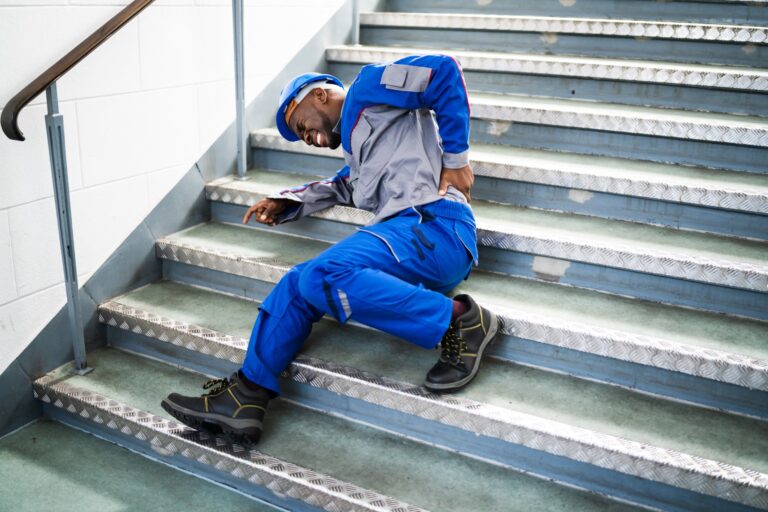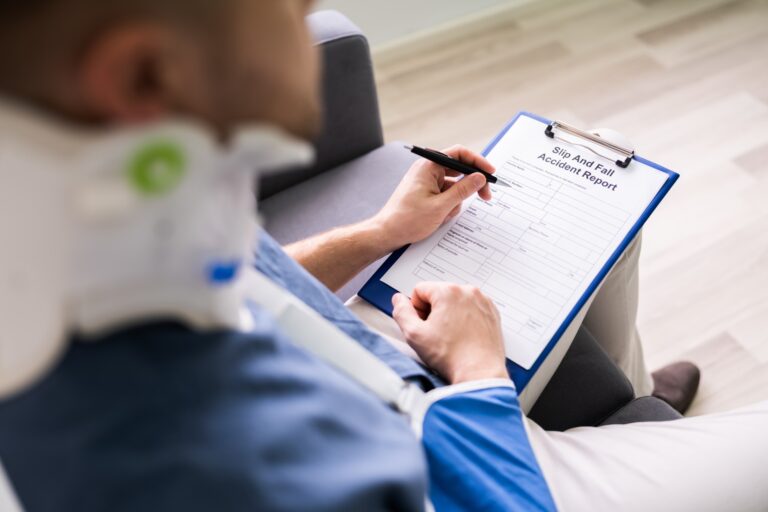
Personal Injuries From Slip & Falls Can Be Serious
Even the most common, everyday activities we all engage in may lead to accidents causing injuries that can drastically change our lives. Picking up groceries, exercising in our local gym, simply carrying out our duties at work, or even just walking down the street can end up leaving us injured. Slip, trip, and fall incidents are some of the most common types of accidents that take place daily in the U.S. They range from slipping on a wet supermarket floor or an icy car park to falling off stairs or escalators, often because of loose or broken handrails, or tripping and falling on an uneven sidewalk or a pothole.
Thus, it must be noted that, most tragically, death cannot be dismissed as a possible outcome of slip-and-fall accidents, with such cases mainly being addressed by the filing of a wrongful death action.
If you have recently been the victim of a slip-and-fall accident that has left you injured, you may wish to consider receiving professional advice on the possibility of filing a lawsuit with the aim of recovering compensation for economic, but possibly also non-economic loss you have suffered as a result. Contact our Centennial personal injury attorneys today to learn about your legal options. Call (303) 351-2567.
Common Causes of Slip & Fall Injuries
No matter how you came to experience a slip-and-fall accident, the outcome is the same: you end up falling, either from ground level or from a height, and injure yourself, perhaps even severely. While the classic comedic slipping on a banana peel may seem funny in a movie, the reality of such accidents can be very onerous, indeed.
Slip, trip, and fall incidents account for 15% of all accidental deaths in the United States—a cause second only to motor vehicle crashes.
Defective handrail
Slipping on snow/ice
Malfunctioning doors
Wheelchair ramp hazards
Escalator / elevator accidents
Unsafe store displays
Slip & falls are the primary cause of days missed from work
Each year, they account for more than one million emergency room visits, making up for a whopping amount of approximately $70 billion awarded annually for compensation and medical costs for employee slip-and-fall-related incidents.
The Impact of Slip & Fall Injuries
Injuries resulting from slip-and-falls range from superficial cuts, bruises, and lacerations, to hurting your back or hip, sustaining knee damage, ending up with broken bones—or, worse, being left with spine and nerve damage or suffering a traumatic brain injury, with everything that each of these may entail for your life. Such accidents can leave you impaired for months, or even years, adversely affecting all kinds of daily activities.
At the same time, they often lead to spiraling medical bills and other connected expenses, not to mention requiring that you be out of work for months or even years, in addition to the devastating emotional effects they may have on you and your loved ones. The time it takes to recover from a slip and fall can vary greatly between cases, but regardless if you are hurt for 4 months, 2 years, or the rest of your life, slip & fall injuries must be taken seriously with treatment from a medical professional.
What Is the Process of a Slip and Fall Lawsuit in Colorado?
Slip-and-fall lawsuits are a type of personal injury case occurring when a person falls to the ground because of another person’s wrongdoing and suffers injury. They are based on Colorado premises liability law and are subject to the Colorado Premises Liability Act, referred to as the PLA (Title 13 of the Colorado Revised Statutes). The PLA sets forth certain legal statuses, as well as accompanying standards of care associated with each of them, and different requirements to prove a claim for damages.
Plaintiff Classification – Legal Statuses
Pursuant to Colorado premises liability laws, a person who is injured while being on the property of another falls into one of three categories (legal statuses) connected to the reason why they found themselves on said property in the first place.
The three legal statuses relevant to premises liability cases are:
- Trespassers: people who enter or remain on the property of another without the property owner’s consent.
- Licensees: most commonly social guests (such as dinner guests at another person’s home) but, generally, those entering or remaining on a property with the permission of the property owner.
- Invitees: usually customers or tenants. For example, if you are shopping at a grocery store, having a coffee at your local cafe, or renting an apartment, you are an invitee of the respective business and property owners.
Duty of Care, Breach, Causation, and Ensuing Harm
It must become clear from the outset that not all slip-and-fall accidents may give rise to a (successful) lawsuit. For an accident that causes injury to be appropriate for a lawsuit, you must show that the defendant(s) acted negligently (or intentionally, as the case may be with trespassers) and prove that all of the components of negligence were in place—that is duty, breach, causation, and damages/harm. Only then may you recover damages.
More specifically, if you are a plaintiff in a slip-and-fall lawsuit, you will need to prove that:
- The person(s) being sued owed you a duty of care, based on your aforementioned legal status. Note that, as a trespasser, you are only owed a duty of care when intentional harm is at hand.
- They breached that duty of care.
- Said breach on the part of the defendant(s) was what caused your injury; and
- You sustained injuries that can be quantified in monetary damages.
Documentation of Injuries
It goes without saying that you will need to document and prove the nature, extent, and impact of the physical injury you suffered as a result of your fall, based on solid evidence. To this end, it is important to keep all relevant medical paperwork as organized and easily accessible as possible.
As hard as it may be to act calmly and purposefully after an accident, it is vital to do everything you can to preserve the accident scene: slip-and-fall cases are, by their very nature, difficult to prove. They often involve highly demanding investigation and meticulous collection of evidence—and evidence fades. Therefore, if you are able to do so, photograph the scene and any damage you have sustained—capture that spill on the grocery store floor, the loose rugs, inadequate lighting or the icy parking lot that led to your fall, as well as your bruises, lacerations, bleeding, and any other visible injuries that you sustained.
Recovering Damages in a Colorado Slip and Fall Case
In a slip-and-fall accident, you may recover economic and non-economic damages due to the defendant’s breach of duty with the help of a Centennial premises liability attorney:
- Economic damages: These include medical bills, rehabilitation costs, and lost income, including future wages.
- Non-economic damages: These cover pain, suffering, emotional distress, loss of companionship, and loss of enjoyment of life. These are harder to quantify and assess based on various factors.
- Punitive damages: Rare but possible, these are awarded for particularly egregious behavior to punish and deter the defendant.
Damage caps in Colorado (as of March 2022) include:
- $642,180 cap for non-economic damages, which can be increased to $1,284,370 with clear and convincing evidence.
- $642,180 cap for wrongful death-related non-economic loss, except in cases of felonious killing.
- For accidents under the Ski Safety Act, total damages are capped at $1 million, with a $250,000 cap on non-economic damages.
- For medical malpractice claims, total damages are capped at $1 million, with a $250,000 cap on non-economic damages.
- Punitive damages, if applicable, cannot exceed the amount of actual damages awarded.
How Damages Are Awarded & Adjusted
An important point that must be made with regard to recovery of damages for slip-and-fall accidents in Colorado is that our State law uses a modified comparative fault rule in determining how damages are awarded and adjusted. This is based on the principle of comparative negligence, which provides that when an accident occurs, the fault and/or negligence of each party involved is based upon their respective contributions to the accident.
In plain English, the question of whether you had any fault in causing your injury will be taken into consideration when calculating the damages you will be awarded. Consequently, if it is found that your injury was partially due to inattention, poor decision-making, or illegal activity on your part, your damages may be reduced by your percentage of fault.
In accordance with the provisions of the PLA, you may still receive compensation from the person or entity responsible for your accident and resulting injury even if a jury finds that you were partly to blame for your slip-and-fall. Nevertheless, any award ordered by the court will be reduced. Indeed, the PLA also stipulates that you effectively lose the case if you are found to be 50% or more responsible for causing the incident leading to your slip-and-fall, and may not recover any compensation at all from the co-negligent party.
Calculation of damages and potential contribution to the accident leading to your injury on your part, as well as rebutting defenses of property owners require knowledge, expertise, and skill in this complicated area of law.
In practical terms, if you suffer a slip-and-fall and are awarded $50,000 in economic damages plus another $50,000 for pain and suffering and other non-economic loss by the jury, but it is also determined that you were 30% at fault for your injury because you were “walking distracted,” for example, your $100,000 award will be reduced by $30,000. Consequently, the final compensation you will receive will be $70,000. Had it been determined that your percentage of liability for the accident came to 51%, you may not have been able to recover any damages whatsoever.
Bearing the above in mind, it is clear that property owners/defendants routinely put forward one of two defenses, namely that:
- They were not negligent in their conduct; or
- The accident and ensuing injury were your fault.
In the first instance, property owners attempt to show that they exercised reasonable care and practiced all necessary due diligence to keep their property safe for customers, contending that the cause of the injury lay outside of their control.
Likewise, defendants will often try to claim that the injured party was actually responsible (or partly responsible) for causing their own accident, relying on the fact that all of us are also required to exercise due care to avoid injuring ourselves: failing to do so means that others should not be held accountable for our own negligence.

Contact Our Colorado Slip and Fall Attorneys Today
Slip-and-fall accidents can end up upending one’s life on many levels and in ways most of us cannot possibly foresee. In view of the many and complex laws and requirements applicable, the pressing time limitations for filing your action, the extensive evidence that needs to be collected, and so on, it is always best to seek professional advice sooner rather than later in order to build a strong case and prepare for refuting any assertions that may be made by the defendant(s).
At Legal Help in Colorado, our Colorado slip and fall lawyers have extensive experience in all types of slip-and-fall cases and are committed to helping injured people get their lives back to normal after accidents. Reach out to us today, initial consultations are free.




